Astrid of Sweden
This article has multiple issues. Please help or discuss these issues on the talk page. (Learn how and when to remove these template messages)
|
| Astrid of Sweden | |||||
|---|---|---|---|---|---|
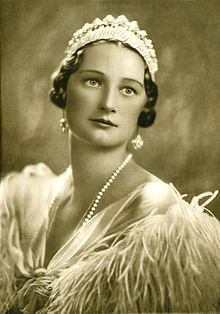 Queen Astrid in 1935 | |||||
| Queen consort of the Belgians | |||||
| Tenure | 17 February 1934 – 29 August 1935 | ||||
| Born | Princess Astrid of Sweden 17 November 1905 Arvfurstens palats, Stockholm, Sweden | ||||
| Died | 29 August 1935 (aged 29) Küssnacht am Rigi, Schwyz, Switzerland | ||||
| Burial | 3 September 1935 Church of Our Lady of Laeken, Brussels, Belgium | ||||
| Spouse | |||||
| Issue | |||||
| |||||
| House | Bernadotte | ||||
| Father | Prince Carl, Duke of Västergötland | ||||
| Mother | Princess Ingeborg of Denmark | ||||
Princess Astrid of Sweden (17 November 1905 – 29 August 1935) was the Queen of the Belgians as the first wife of King Leopold III. Originally a princess of Sweden of the House of Bernadotte, Astrid became the Duchess of Brabant after her marriage to Leopold in November 1926. She became queen of the Belgians on 17 February 1934 until her death. Her charity work revolved around women, children, and disadvantaged people.
Astrid's only daughter, Joséphine-Charlotte, later became Grand Duchess consort of Luxembourg, while both of her sons reigned as King of the Belgians. Astrid was also a sister of Crown Princess Märtha of Norway (wife of King Olav V) and a maternal aunt of King Harald V of Norway.
Early life[]

Princess Astrid was born on 17 November 1905, at the Arvfurstens Palats in Stockholm as the third child and youngest daughter of Prince Carl, Duke of Västergötland, and his wife, Princess Ingeborg of Denmark. Her father was the third son of Oscar II, King of Sweden and Norway, by his wife, Sophia of Nassau. Her mother was a daughter of King Frederick VIII of Denmark by his wife, Louise of Sweden. Astrid's father was a younger brother of King Gustav V of Sweden; her mother was the younger sister of kings Christian X of Denmark and Haakon VII of Norway.[citation needed]
Astrid had two elder sisters Margaretha, Princess Axel of Denmark, and Märtha, Crown Princess of Norway, and a younger brother Prince Carl Bernadotte (prev. Prince Carl of Sweden, Duke of Östergötland).[citation needed]
Astrid spent most of her childhood at Arvfurstens Palace in central Stockholm and at the family's summer residence in Fridhem. Astrid was raised in strict education and without much luxury. Astrid attended the Sint Botvid boarding school, where lessons were taught in French. She then went to Akerstrom-Soderstrom finishing school, where she studied sewing, piano, ballet and childcare.[citation needed] After finishing school, Astrid worked at a Stockholm orphanage, caring for children.[2]
Engagement and wedding[]
This section does not cite any sources. (November 2021) |

As an eligible princess, Astrid was mentioned as a potential bride for a number of princes including the future Edward VIII of the United Kingdom and the future Olav V of Norway. Astrid's successful suitor was Prince Leopold of Belgium, Duke of Brabant.
In September 1926, their engagement was announced. King Albert I and Queen Elisabeth of Belgium invited the press to the royal palace in Brussels. "The Queen and I," declared Albert, "would like to announce to you the impending marriage between Prince Leopold, Duke of Brabant and the Princess Astrid of Sweden. We are convinced that the princess will bring joy and happiness to our son. Leopold and Astrid have decided to join their lives without any pressures or reasons of state. Theirs is a true union among people with the same inclinations." Queen Elisabeth said: "It is a marriage of love... tell it to our people. Nothing was arranged. Not a single political consideration prevailed in our son's decision."

In Stockholm on 4 November 1926 civilly and in Cathedral of St. Michael and St. Gudula, Brussels on 10 November religiously, Princess Astrid married Prince Leopold. The couple travelled separately to Antwerp after their civil marriage, to be reunited in Belgium. For the religious marriage, the couple were attended by a large wedding party of young friends and relatives: Princess Feodora of Denmark, Princess Marie-José of Belgium, Princess Märtha of Sweden, Princess Ingrid of Sweden, Alfhild Ekelund, Prince Carl of Sweden, Prince Gustav Adolf of Sweden, Crown Prince Olav of Norway, Margareta Stähl, Count Claes Sparre, Anna Adelswärd, Prince Charles of Belgium, Count Folke Bernadotte, Baron Sigvard Beck-Friis, Anne Marie von Essen, and Baron Carl Strömfelt.[citation needed]
Princess Astrid was given a tiara as a wedding gift from the Belgian government, created by Belgian jeweler Van Bever, the original version of the diadem is a flexible diamond bandeau in a stylized Greek key motif topped with 11 large diamonds on spikes. These large stones, totaling around 100 carats on their own, symbolize the nine provinces of Belgium and the (now former) Belgian colony of the Congo.[citation needed] She later added a set of diamond arches to enclose each of the 11 independent stones. After Astrid's death the tiara was in the possession of King Leopold, and his second wife Lilian, Princess of Réthy wore parts of the tiara but not the full gem (Lilian never held the title of Queen). Leopold abdicated the throne in favor of his son Baudouin; when Baudouin married, Leopold gave the tiara to the new queen. Fabiola, Belgium's first queen since Astrid, wore it on her wedding day. She handed the jewel over after Baudouin's death to be worn by Queen Paola who, after the abdication of her husband Albert, gave it to Mathilde new Queen of the Belgians.[citation needed]
Duchess of Brabant[]

The Duke and Duchess of Brabant spent their honeymoon in south of France before moving into a wing of the Royal Palace of Brussels. After the honeymoon period, Princess Astrid began learning French and Dutch.[citation needed] Astrid was enthusiastically adopted by the Belgians. She was widely loved for her beauty, charm and simplicity. Her public and official engagements radiated enthusiasm. As the Duchess of Brabant, she worked to alleviate various forms of adversity.[3]

In October 1927, Leopold and Astrid had a daughter, Princess Joséphine-Charlotte (later Grand Duchess of Luxembourg). The birth of her only daughter had been a tough period for Astrid for women were barred from the line of succession to the throne.[citation needed] One year later, she and her husband visited the Dutch East Indies (now Indonesia).[4] They arrived with Insulinde ship.[5] When the couple visit Surakarta, Astrid and her husband received a box with gold kris inside as a present from the Dutch East Indies government.[5] Princess Astrid received a box with a fan inlaid with gold inside as a gift.[5] Local people admired Princess Astrid's warm, enthusiastic and less formal attitude.[5] The couple visited Radio Poestoko Museum and Societet Habiprojo where they watch wayang show.[5] They also visited Surabaya and Bali.[5] After spent five months in the Dutch East Indies, the couple moved back to Belgium with Tjerimai ship.[5] Upon their return from Dutch East Indies, the couple moved into Stuyvenberg Castle.[citation needed] In September 1930, Astrid gave birth to Prince Baudouin, who eventually became King of the Belgians.[citation needed]
Raised as a Lutheran, Astrid converted to Catholicism after marrying Leopold. She had initially considered converting to Catholicism, simply because it was the religion of Belgium, but the priest she consulted, Father William Hemmick, told her not to do so until she genuinely believed it was the true religion.[6] Astrid learned more about Catholicism and, several years later, in 1930, converted from genuine conviction. Her decision made her happy, and she confided to a close childhood friend: "My soul has found peace."[7] Her father-in-law, King Albert I, who was very devout himself, repeated, on the day of Astrid's conversion: "I am glad, very glad. Now all the family is united in the same religion."[8]
In 1932, Astrid and her husband traveled Asia and Congo. Their children stayed with Astrid's parents in Sweden.[citation needed] According to May 1933 print of De Locomotief, the photos of their visit to the Dutch East Indies were published as a photo collection book titled De Reis van Prins Leopold door Ned-Indie.[5] After the visit to the Congo, she wrote to her friend Countess Anna Sparre (née Baroness Anna Adelswärd) about her impression of the Congo.[9] In her letters, Princess Astrid wrote about the majestic landscapes of Congo land and her concerns about suffering, poverty and infant mortality that Congolese faced.[9] Her husband entirely shared her sentiments.[9]
The Duchess of Brabant became a godmother of Anna Sparre's daughter, Christina,[10] and her sister Crown Princess Märtha's second daughter, Princess Astrid.[citation needed]
Queen[]
On 17 February 1934, King Albert I died in a mountain-climbing accident in Marche-les-Dames, Belgium. Leopold and Astrid became the new King and Queen of the Belgians with the style of Majesty. Later that year, the third child of Leopold and Astrid was born. He was named Albert after his grandfather, and would eventually succeed his brother Baudouin as King of the Belgians.
As a queen of the Belgians, Astrid dedicated her time to raising her children and promoting social causes that brought her into contact with the Belgians. She was very concerned with the situation of women, children, and disadvantaged people. During an economic crisis in Belgium in 1935, she organized a collection of clothing, money and food for the poor. She did this through an open letter, which was published as the "Queen’s Appeal". Queen Astrid also visited poor settlements in Belgium.[9]
Queen Astrid was particularly interested in training women formally in childcare and healthcare.[11] She also supported the training of young girls as dressmakers so they would have better career opportunities.[11] She supported Catholic charitable institutions, such as the Sisters of St. Vincent de Paul and liberal organizations, such as the Fédération des Foyers Belges.[11] She also gave audiences to advocates of women's rights such as Baroness Marthe Boël, president of the National Council of Belgian Women.[11]
In May 1935, Queen Astrid patronized Milk Week, an effort to encourage Belgians to drink healthy beverages. She took this opportunity to charge Gatien du Parc, one of her courtiers, with the task of preparing a detailed report on milk regulations in foreign countries. The investigation was very strict.[11] Queen Astrid often did charitable works as part of a Relief Committee.[12][better source needed]
Hobbies and personality[]
Queen Astrid had a warm, friendly, social and charming personality.[citation needed] According to her friend Countess Anna Sparre, Astrid was a shy and insecure woman.[9] Sparre believed that Astrid's mother Princess Ingeborg's constant praising of her sister Märtha contribute to her shyness and insecurity.[9] Astrid, who apparently a timid and fragile woman, can be fierce and stern, when she had to defend a wronged loved one.[13]
She collected Swedish folk art and enjoyed sports such as swimming, skiing, climbing, horseback riding and golf.[citation needed]
Death[]
This section does not cite any sources. (November 2021) |

In August 1935, the King and Queen went incognito to their holiday home, Villa Haslihorn in Horw, on the shores of Lake Lucerne, Switzerland. Joséphine-Charlotte and Baudouin travelled with their parents, while the one-year-old Prince Albert was considered too young for the journey and remained in Brussels. The children returned to Belgium with their nannies on 28 August.
On 29 August 1935, the King and Queen went for a last hike in the mountains before returning home. Their chauffeur was sitting in the back of the Packard One-Twenty convertible; the King was driving and the Queen looking at a map. At approximately 9:30 am the Queen pointed out something to her husband, who looked away from the road for an instant. The car left the road, travelled down a steep slope, and collided with a pear tree. Queen Astrid had opened her door and was thrown out upon impact. Her body struck the trunk of the tree while the car hit a second tree. King Leopold was thrown from the car and only lightly injured. The car continued and stopped in a lake. The Queen died from her injuries at the scene of the accident at Küssnacht am Rigi, near Lake Lucerne, Schwyz, Switzerland. Witnesses recalled a single scream, "Astrid!!!", as Leopold held her bloodied body to his chest.
Queen Astrid is interred in the royal vault at the Church of Our Lady of Laeken, Brussels, beside her husband, King Leopold III, and his second wife, Lilian, Princess of Réthy.
Legacy[]
Folklore[]
, a Swiss historian, describes how Queen Astrid entered folklore in Belgium and Switzerland.[14] Months after her death, newlyweds were bringing flowers to the place where the Queen died.[14] The chapel visitors would also bring wreaths and candles.[14] The visits peaked on feasts of All Saints and All Souls.[14] The Queen was described as an icon of beauty, kindness, romance, marriage and a model Catholic.[14] Mayor of Küssnacht told the Belgian Ambassador to Switzerland: "It is on pilgrimage that these couples arrive here from all over the canton. These young newlyweds, in bridal dress, whom you saw visiting the place where Queen Astrid passed away, are imploring her protection. Your young Queen has become part of Swiss legend; she is, for our people, who have beatified her in their hearts, the symbol of maternal love and conjugal fidelity."[14]
Memorials[]
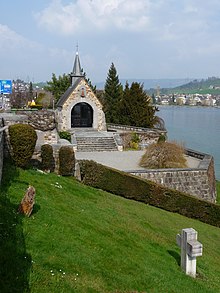
In 1935, the Belgian postal authorities issued a postage stamp showing her portrait outlined in black, known as the Astrid Mourning issue. Later that same year, it released a series of anti-tuberculosis fund stamps with the same design.[15] in 8th arrondissement of Paris was named in her memory.[16]
A commemorative chapel named Astrid Chapel[17][18] was built in Switzerland at the site of the crash. The Swiss government gave the land to Belgium a year after Astrid's death and the chapel was built in the style of a Walloon country church.[19] The chapel has become a destination for Swedish and Belgian tourists.[20] The King's Cross, built in where the Queen died in her husband's arms, is made from Swedish granite.[21][22] A museum nearby holds images and memorabilia of the event, including a shard from the windscreen and the log of the pear tree. The tree itself was felled by a storm in 1992. The car was sunk at a deep part of the Vierwaldstättersee at the request of the king.[20]
A memorial was built by the architect Paul Bonduelle in Laeken, Belgium, and inaugurated on 21 July 1938. The building, which is in the late neo-classical style, faces the Church of Our Lady of Laeken and backs onto the Palace of Laeken. The same year, on the initiative of the local Veterans' Front, a bronze bust of the Queen was erected in Wisterzée Park in Court-Saint-Étienne, Belgium, by sculptor Victor Rousseau.[citation needed]
Astrid Avenue in Bogor Botanical Garden in Indonesia (formerly Dutch East Indies) was named after her while she was honeymooning there with her spouse in 1928. The avenue is decorated with spectacular displays of canna lilies of various colors.[23][4] The Swedish layer cake Princess cake was named after Astrid and her two sisters when they were children.[24][25][unreliable source?]
Names[]
Four of her descendants were named Astrid to honour her. Her granddaughters Princess Marie-Astrid of Luxembourg, Princess Astrid of Belgium, her great-granddaughter Princess Marie-Astrid of Liechtenstein, and her great-great-granddaughter Archduchess Anna Astrid of Austria-Este. Her niece Princess Astrid of Norway (later Mrs. Ferner) was named to honour her.[26] Her husband King Leopold III's first daughter with his second wife Lilian Baels, Princess Marie-Christine Daphné Astrid Élisabeth Léopoldine of Belgium (b. 1951), was named after her.
Titles[]
Titles and Styles[]
- 17 November 1905 - 4 November 1926: Her Royal Highness Princess Astrid of Sweden
- 4 November 1926 - 17 February 1934: Her Royal Highness The Duchess of Brabant
- 17 February 1934 - 29 August 1935: Her Majesty the Queen of the Belgians
Gallery[]
Statue of Astrid in a park at Kortrijk named for her
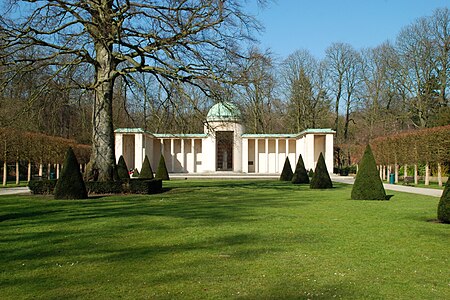 Queen Astrid Memorial in Laeken
Queen Astrid Memorial in Laeken
(architect Paul Bonduelle, 1938).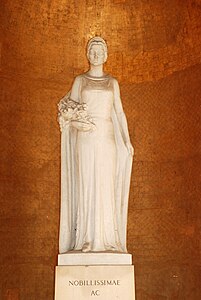 Statue of the Queen in the Queen Astrid Memorial in Laeken.
Statue of the Queen in the Queen Astrid Memorial in Laeken.
Arms[]
 Alliance Coat of Arms of King Leopold III and Queen Astrid of Belgium |
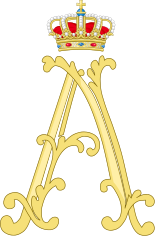 Royal Monogram of Queen Astrid of Belgium |
Ancestry[]
This section does not cite any sources. (November 2021) |
| Ancestors of Astrid of Sweden | |||||||||||||||||||||||||||||||||||||||||||||||||||||||||||||||||||||||||||||||||||||||||||||||||||||||||||||||||||||||||||||||||||||||||||||||||||||||||||||||||||||||||||||||||||||||||||||||||||||||||||||||||||||||||||||||||||||||||||||||||||||||||||||||||||||||||||||||||||||||||
|---|---|---|---|---|---|---|---|---|---|---|---|---|---|---|---|---|---|---|---|---|---|---|---|---|---|---|---|---|---|---|---|---|---|---|---|---|---|---|---|---|---|---|---|---|---|---|---|---|---|---|---|---|---|---|---|---|---|---|---|---|---|---|---|---|---|---|---|---|---|---|---|---|---|---|---|---|---|---|---|---|---|---|---|---|---|---|---|---|---|---|---|---|---|---|---|---|---|---|---|---|---|---|---|---|---|---|---|---|---|---|---|---|---|---|---|---|---|---|---|---|---|---|---|---|---|---|---|---|---|---|---|---|---|---|---|---|---|---|---|---|---|---|---|---|---|---|---|---|---|---|---|---|---|---|---|---|---|---|---|---|---|---|---|---|---|---|---|---|---|---|---|---|---|---|---|---|---|---|---|---|---|---|---|---|---|---|---|---|---|---|---|---|---|---|---|---|---|---|---|---|---|---|---|---|---|---|---|---|---|---|---|---|---|---|---|---|---|---|---|---|---|---|---|---|---|---|---|---|---|---|---|---|---|---|---|---|---|---|---|---|---|---|---|---|---|---|---|---|---|---|---|---|---|---|---|---|---|---|---|---|---|---|---|---|---|---|---|---|---|---|---|---|---|---|---|---|---|---|---|---|---|
| |||||||||||||||||||||||||||||||||||||||||||||||||||||||||||||||||||||||||||||||||||||||||||||||||||||||||||||||||||||||||||||||||||||||||||||||||||||||||||||||||||||||||||||||||||||||||||||||||||||||||||||||||||||||||||||||||||||||||||||||||||||||||||||||||||||||||||||||||||||||||
References[]
- Catherine Barjansky. "Portraits with Backgrounds."
- Art Beeche. "The Snow Princess."
- Robert Capelle. "Dix-huit ans auprès du Roi Léopold."
- Charles d'Ydewalle. "Albert and the Belgians: Portrait of a King."
- Evelyn Graham. "Albert King of the Belgians."
- Luciano Regolo. "La Regina Incompresa."
- Lars Rooth. "More Joy Than Pain."
- Anna Sparre. "Astrid mon amie."
- ^ Burke's Royal Families of the World ISBN 0 85011 023 8 p. 514 (spelling of her full name as baptized)
- ^ Abi, Jo (7 August 2020). "The short and tragic life of Queen Astrid of Belgium". Retrieved 15 April 2021.
- ^ "Princess Astrid (1905-35)". Swedish Royal Court.
- ^ a b Priherdityo, Endro (16 March 2016). "Kisah Cinta Putri Belgia Masih Tersimpan di Kebun Raya Bogor" [The Memory of Belgian Princess's Love Story Is Still Saved in the Bogor Botanical Garden]. CNN Indonesia (in Indonesian). Retrieved 23 October 2018.
- ^ a b c d e f g h Janti, Nur (17 June 2020). "Kunjungan Putra Mahkota Belgia Leopold dan Putri Astrid ke Hindia Belanda" [Visit of the Belgian Crown Prince Leopold and Princess Astrid to the Dutch East Indies]. Historia (in Indonesian). Retrieved 30 May 2021.
- ^ More Joy Than Pain, 1991, by Lars Rooth pp. 84–85
- ^ Quoted by Anna Sparre in Astrid mon amie, 2005, p. 128
- ^ Quoted by Charles d'Ydewalle in Albert and the Belgians: Portrait of a King, 2005, p. 259
- ^ a b c d e f Sparre, Anna. Astrid mon amie. 2005.
- ^ Sparre, Anna. Astrid mon amie. 2005. ""But I promised I would look after my god-daughter, Christina, if something happened to you," she answered, trying to smile."
- ^ a b c d e Koninckx, Christian; Libert-Vandenhove, Louise-Marie. Astrid: 1905-1935 (2005). pp. 103-115.
- ^ "Koningin Astrid van België (1935)" (in Dutch). 18 April 2019. Archived from the original on 2021-12-11. Retrieved 3 April 2021 – via YouTube.
- ^ Sparre, Anna. Astrid mon amie. 2005. p. 114
- ^ a b c d e f Réactions à la mort de la reine Astrid, 1905-1935, document of historian .
- ^ Stanley Gibbons Simplified catalogue. Stamps of the World, 1985 Edition
- ^ "LA PLACE DE LA REINE ASTRID". paristoric.com (in French). Retrieved 15 April 2021.
- ^ "ASTRID KAPELLE KÜSSNACHT AM RIGI". zug-tourismus.ch.
- ^ "Astrid Kapelle, Küssnacht am Rigi". rigi.ch.
- ^ "Bericht über den Besuch des Belgischen Königs Albert II. in Küssnacht". Neue Zürcher Zeitung. 2010-08-29. Retrieved 2017-02-06.
- ^ a b Der belgische König kommt nach Küssnacht Archived 2012-04-26 at the Wayback Machine Neue Zürcher Zeitung
- ^ Schwarzenbach, Alexei (1998). Rêves Royaux. Réactions à la mort de la reine Astrid, 1905-1935 . p. 22.
- ^ "Mort de la reine Astrid: le roi des Belges sur les lieux du drame" [Death of Queen Astrid: the King of the Belgians at the scene of the tragedy]. tdg.ch (in French). 29 August 2015.
- ^ "Taman Astrid - Kebun Raya Bogor". Lovely Bogor (in Indonesian).
- ^ "Traditionsenlig tårtfrossa - Prinsessyra bäddar för prinsesstårtans vecka" (in Swedish). Cisionwire. 2009-09-17. Archived from the original on 2010-10-17. Retrieved 2009-12-19.
- ^ Vera (2009-02-24). "Swedish Princess Cake". Retrieved 2014-01-26.
- ^ "Princess Astrid celebrates her 80th birthday". Norwegian Royal House. 11 February 2012. Retrieved 28 September 2019.
External links[]
| Wikimedia Commons has media related to Astrid of Sweden. |
- Royal Love Match (1926), newsreel on the British Pathé YouTube Channel
- Tragic Death of the Queen of the Belgians (1935), newsreel on the British Pathé YouTube Channel
- Portraits of the Nation: Postage Stamps and National Identity
- The making of a Belgicist reference to Villa Haslihorn
- Packard Club images from the Packard car after the accident
- BELGIUM: Death of Astrid Time article
- Newspaper clippings about Astrid of Sweden in the 20th Century Press Archives of the ZBW
- 1905 births
- 1935 deaths
- Duchesses of Brabant
- Belgian queens consort
- Naturalised citizens of Belgium
- Swedish princesses
- House of Bernadotte
- Princesses of Saxe-Coburg and Gotha
- Dames of Malta
- Converts to Roman Catholicism from Lutheranism
- Swedish Roman Catholics
- Road incident deaths in Switzerland
- Belgian princesses
- Belgian people of Swedish descent
- People from Stockholm
- Burials at the Church of Our Lady of Laeken
- Former Lutherans
- House of Saxe-Coburg and Gotha (Belgium)



